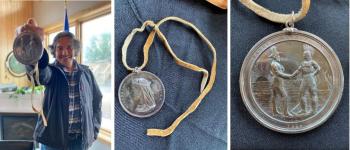Image Caption
Summary
Local Journalism Initiative Reporter
Windspeaker.com
A treaty medallion on its original leather strap has returned home to the Athabasca Chipewyan First Nation (ACFN) in northern Alberta.
“It was significant in a way that when you look at (it as) a medallion that was given based on the fact of treaty signing. To have it returned to our nation, not a replica, the original one, makes it even more significant because of that history it has behind it,” said ACFN Chief Allan Adam.
The treaty medallion was given to the first chief of ACFN at the signing of Treaty 8 in 1899 in what is now known as Grouard.
The medallion and its associated leather strap are the first of seven cultural items that the Royal Alberta Museum in Edmonton will be returning to the First Nation. Also in the museum’s possession are a Treaty 8 Headman’s suit (pants and jacket), two fish boxes and a canoe.
Adam says he was “given the task” to bring home the medallion and Headman’s suit when he became chief 14 years ago. At that time, an Elder told him that the medallion and suit belonged to her grandfather.
“She told me who she gave it to and everything at the time and from there on in we just did some backtracking and we ended up finding it,” said Adam.
The artifacts were tracked to the Royal Alberta Museum (RAM) where they had been sent for safekeeping, he says.
The museum received a request from ACFN to transfer the medallion and suit in 2012, but a transfer agreement could not be reached, said Savannah Johannsen, spokesperson for the minister of culture.
In 2020, the discussions began again.
“Representatives of the ACFN approached the RAM to ask about Denesuline objects in the collection, specifically those associated with former chiefs and Treaty 8. This started a conversation about an appropriate process to return the objects,” said Johannsen.
The treaty medallion was on display in the Human History Hall until it was removed to be repatriated. The treaty suit remains on display in that same hall.
Adam says the delay in having the remaining items returned is two-fold.
“The Alberta government … is saying the old artifacts don’t have the right atmosphere. It’ll fall apart and break. Giving all kinds of excuses,” he said.
Johannsen says RAM has no requirements as to how the items should be stored or displayed by ACFN. She adds that because they are fragile, the museum has offered to hold on to them until ACFN has an appropriate space available.
“As the ownership of these objects is being returned to their community, (ACFN has) full control over how they are cared for,” she said.
Adam says on Sept. 8, when the medallion and strap were repatriated, he signed a document with the Alberta government that confirmed ACFN’s claim to the items.
However, he adds, ACFN has no place to safely store or display the returned items so they will remain with the museum.
“We don’t have the facility. We don’t have the space for it all. It would be lovely if we did, but we just don’t have that opportunity,” said Adam.
ACFN is in the process of building a new band office, which will include space to safely store and display the artifacts. Adam is hoping the building will be completed in the next five years.
While ACFN was able to find these pieces at RAM, Adam is concerned about the pieces they are not able to track down. He points out that some of the pieces that will be repatriated were not on display at RAM but were instead held in storage.
“There could be artifacts there that belong to other First Nations that they don’t know of,” he said.
Johannsen says RAM has been working with First Nation communities to return their sacred objects for decades.
In 2000, the province passed the First Nations Sacred Ceremonial Repatriation Act. The only regulations established for returning such objects were to Blackfoot Nations.
There is still no formal process in place for returning Cree, Nakota, and Saulteaux and Denesuline ceremonial objects, says Johannsen.
“Requests will be discussed with Indigenous communities on a case-by-case basis. Museum staff have been engaging in conversations with First Nation representatives, Treaty organizations, Elders and knowledge holders about creating a process that fits within their cultural context and how we might work together to return these belongings to their communities,” she said.
However, Johannsen points out, the items identified by ACFN were not sacred ceremonial and fell under the Historical Resources Act, also legislated in 2000.
“The Royal Alberta Museum is committed to building strong, respectful relationships with First Nations communities, and honouring their connections to the ancestral belongings and sacred objects in our care,” she said.
Adam thinks museums like RAM should be proactive instead of waiting for First Nations to approach them.
“What makes my mind think now, how many artifacts does the Alberta museum have now that they don’t really need? They should be sending them back to the First Nations people,” he said.
Local Journalism Initiative Reporters are supported by a financial contribution made by the Government of Canada.

